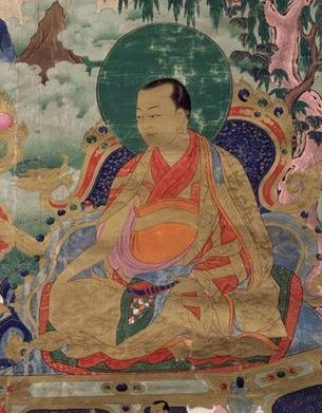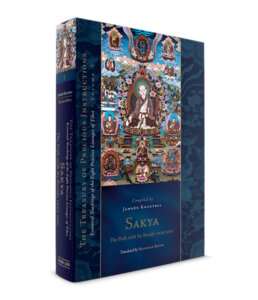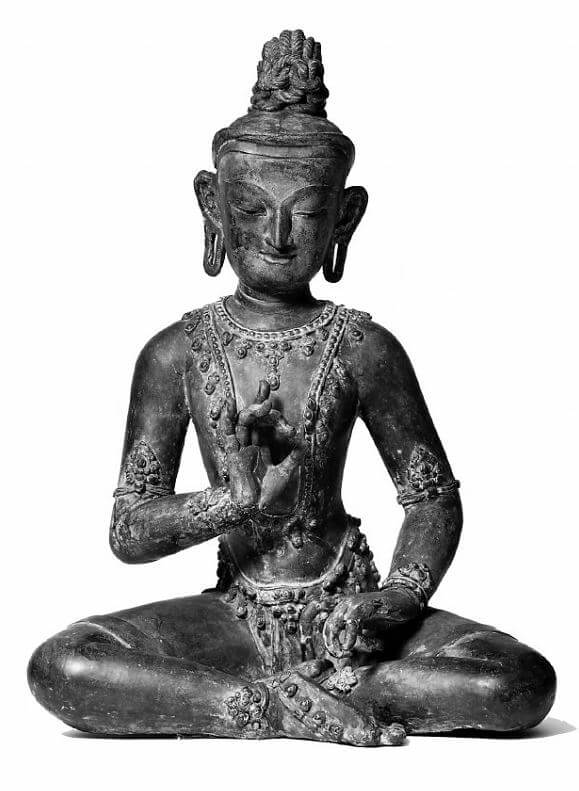Related Reader's Guides
Guide to the Sakya Tradition
Guides to Other Important Sakya Figures: Sakya Pandita | Sakyasribhadra
Related Reader's Guides
Guide to the Sakya Tradition
Guides to Other Important Sakya Figures: Sakya Pandita | Sakyasribhadra

Drogon Chogyal Phagpa Lodro Gyaltsen (1235-1280), better known to the world as Chögyal Phagpa (or Phakpa) is one of the five great founding masters from the Sakya tradition in Tibet. In addition to being the nephew of the great 13th century Sakya master, Sakya Pandita, Chogyal Phagpa was appointed ruler of Tibet and eventually became the teacher of the Mongol emperor Kublai Khan. He was well steeped in Dharma training and practice and composed several texts and commentary throughout his lifetime including writing on civil law, the Buddhist tenet system, and lamdre (Path With Its Result), a system of practice specific to the Sakya School of Tibetan Buddhism.
Before going into the various resources in print and online, included below is his biography of Lama Migmar Tseten's Treasures of the Sakya Lineage.
"Drogon Chogyal Phagpa was born amid excellent signs to Sakya Pandita’s younger brother, Zangtsa Sonam Gyaltsen (1184‒1239), and his wife, Machig Kunkyi, during the wood female sheep year, when his father was fifty-two years old. He recalled his past lives as Saton Riwa, Langriwa, and others. Chogyal Phagpa was taught the Saroruhavajra sadhana when he was three, and the Jatakas when he was eight; when he was nine, Sakya Pandita taught him the Hevajra-tantra. To everyone’s amazement, Phagpa gave an explanation of The Advice for Gathering Accumulations (Sambharaparikatha) by master Vasubandhu that same year, and the pride of scholars was diminished when they heard this explanation from a child. Thinking that an ordinary person could not have such wisdom, they considered him to be an Arya. Thus, he became known to all as Phagpa, which means “Arya.”
At nine he traveled north to attend Sakya Pandita. While in Lhasa, Chogyal Phagpa received novice ordination in front of the Jowo statue, and in Kyormo Lung, he received the Getsul vow from Sherab Pal.
He spent all his time attending Sakya Pandita during his travels and residence in China, until at seventeen Chogyal Phagpa left for Mongolia. Sakya Pandita was very pleased with him for having mastered the outer teachings and the inner Vajrayana teachings, and gave him a white conch to proclaim the Dharma and a begging bowl. Having entrusted his students to him, the master said, “The time has come for you to teach, to benefit many sentient beings, and to recall your promise.” Then Sakya Pandita passed away, having accomplished all he had intended to do.
Having been invited by the Mongolian Khan, Phagpa established the Khan’s faith by performing miracles, such as showing each of the five Buddha families separately by cutting open the five limbs of his body with a sharp sword. Beginning with the Khan, Chogyal Phagpa bestowed the empowerment of Hevajra on twenty-five disciples and brought Vajrayana to the kingdom of Mongolia. The Khan gave Chogyal Phagpa the title of Tishri and thirteen surrounding regions of Tibet as his offering for the empowerment.
At twenty-one, Chogyal Phagpa received full ordination on the border of China and Mongolia from the abbot of Nyethang, Dragpa Senge; the master of ceremonies was Jodan Sonam Gyaltsen. Phagpa received teachings on Abhisamayalankara and other texts from the abbot and on Vinaya from the master of ceremonies.
Two years later, he accepted an invitation to the five-peaked mountain and received many teachings on Yamari from Tong Ton. After that, he returned to the Khan’s palace, and when a Dharma assembly was convened, he defeated twenty-three Chinese teachers in debates and showed them correct view.
When he was thirty, he returned to the seat of Sakya, having been absent from Tibet since he was nine. He gave many teachings there; he also received many teachings on the outer and inner sciences and an ocean of transmissions and instructions from Nyan Wod Srung, the siddha Yontan Pal, Chim Namkhai Drag, Tsog Gom Kunga Pal, Lowo Lotsawa, Chiwo Lheypa Jowo Sey, and others.
After this, he was again summoned to China by the Khan and arrived there when he was thirty-three. He appointed thirteen positions to manage different responsibilities and was offered the rest of the three provinces of Tibet as an offering for empowerments.
At forty-two, having been in China the second time for nine years, he returned to Sakya. He taught a large Dharma festival and used all of his wealth for this event, holding nothing back. He established the basis for a Dharma college and built shrines for the body, speech, and mind of the Buddhas. He gave donations to all the poor people of the region and demonstrated only positive activities toward sentient beings. He spread the Dharma to Tibet, China, and Mongolia; ordained 450,000 novices and fully ordained monks; and bestowed Vajrayana empowerments on people of fourteen different languages. Moreover, he established countless disciples in ripening and liberation through the blessings of transmission and instruction. He gave commentaries on sutras, treatises, and the stages of practice in Hinayana and Mahayana; answered questions; and wrote many texts that are easy to understand.
In the early morning of the eleventh month of the iron male dragon year, when he was forty-six, having endeavored greatly to benefit others, Chogyal Phagpa sat cross-legged, holding his vajra and bell. He crossed his arms, and amid sounds, amazing scents, and a shower of flowers, he passed away.
Chogyal Phagpa was the last of the five founding masters of the Sakya school. Thanks to his efforts, the school ruled Tibet for close to a century; expanded widely; and became the country’s dominant institution of learning for the next two hundred years, producing the most famous scholars in Tibetan history, such as Buton, Dolbuwa, Longchenpa, Rendawa, Tagtsang Lotsawa, Tsongkhapa and his two chief disciples, Rongton, Dagpo Tashi Namgyal, Gorampa, and Shakya Chogden.
Of the five masters, Sachen was considered to be the emanation of Avalokiteshvara; Lopon Rinpoche, Jetsun Rinpoche, and Sapan were regarded as emanations of Manjushri; and Chogyal Phagpa was considered to be an emanation of Vajrapani."
Another excellent biographical source is Thinley Norbu Rinpoche's Ruby Rosary. Chogyal Phakpa was one of the primary incarnations of the Dudjom lineage of the Nyingma tradition. Here is a selection from the biography included:
Drogön Chögyal Phagpa Lodrö Gyaltsen Rinpoche [1235–1280] had the good fortune to be born as the son of Zangtsa Sönam Gyaltsen. He was a Bodhisattva abiding on the higher bhūmis340 who intentionally took rebirth in the human realm. As a result, from the beginning his nature, love, and Bodhisattva conduct were exceptional, and he was adorned with the title Phagpa.341 The inexhaustible treasury of his intelligence and liberating confidence burst open and overflowed. He performed miraculous activities, such as slicing off his head and four limbs with a sharp blade and transforming them into the arrangement of the five Buddha families. This and his perfect deeds of enlightened body, speech, and mind caused unswerving faith to be born in the hostile Mongolian king [Kublai Khan], who went on to receive empowerment from him on three occassions.
$39.95 - Hardcover
A shorter but complementary biography appears in Ringu Tulku's The Ri-Me Philosophy of Jamgön Kongtrul the Great.
The Ri-me Philosophy of Jamgon Kongtrul the Great
$24.95 - Paperback

Volume 5 includes Chögyal Phagpa's The Manual of the Three Purities: The Intention of the Vajrapañjara Tantra. Below is the introduction to his text found in Volume 5 translated by Malcolm Smith.
"The last text presented in this volume was composed by Drogön Chögyal Phakpa (’Gro dgon chos rgyal ’phags pa, 1235–1280), the seventh Sakya throne holder, the fifth of the Sakya founders, and notably the nephew of Sakya Paṇḍita (Sa skya paṇḍita Kun dga rgyal mtshan, 1182–1251), one of the most well-known figures in the political history of Tibet due to his relationship with the founder of the Yuan Dynasty of China, Kublai Khan (1216–1294). Although The Manual of the Three Purities does not form part of the usual curriculum of the Path with Its Result, the practices described in its pages are drawn from that system. The three purities, which are also described in texts such as Amezhab’s Opening the Eye to the Concealed, and so on, include the purity of suchness, which examines the view described in the Hevajra cycle of tantras; the individual purity of the deities, which is related to the creation stage; and the purity of intrinsic cognizance, which is based on completion stage practices."
Sakya: The Path with Its Result, Part One
$44.95 - Hardcover
In addition to the main biography above, Treasures of the Sakya Lineage. contains a translation of his short piece of advice, The Gift of the Dharma to Kublai Khan. This text encapsulates all the Hinayana and Mahayana teachings of the Buddha. It begins with a discussion of civil law and then goes to a discussion of Dharma, covering all the topics of the four tenet systems, as well as the ground, path, and fruit, and ends with a brief discussion of the three kayas.
Treasures of the Sakya Lineage
$24.95 - Paperback
In the Nyingma tradition Chogyal Phagpa continues to be revered as a previous birth of Dudjom Rinpoche.* The previous Dudjom Rinpoche, Jigdral Yeshe Dorje, includes him in the famous Pearl Necklace prayer, a supplication he was asked to compose to his thread of previous lives, that appear in Wisdom Nectar. This is also related, along with a shorty biography, in the Light of Fearless Indestructible Wisdom, the biography of Dudjom Rinpoche by Khenpo Tswang Dongyal.
*To learn more see our Rebirths of the Dudjom Lineage page.
Dzongsar Khyentse Rinpoche in his masterpiece of the Teacher-Disciple relationship, The Guru Drinks Bourbon, recounts this story:
"There is a folktale of a Chinese emperor who never managed to receive proper teachings from Sakya Pandita because he was testing Sakya Pandita again and again. Even though Sakya Pandita proved to be a great master, the emperor’s skeptical habit was ceaseless. Eventually the intended guru, Sakya Pandita, died, and they say that because of this, the people of the Yuan dynasty had to receive the teachings from Sakya Pandita’s nephew, Drogon Chogyal Phakpa.
If you are genuinely seeking the truth, you have to come to a conclusion at some point. Otherwise, like the Chinese emperor, you’ll end up wasting your time. If you keep on analyzing somebody, you will always find faults."
Chogyal Phagpa's legacy extends into the artistic realm as well. The Art of Buddhism tells how he invited the Nepalese artist Aniga along with a group of others to Beijing where they profoundly influenced Chinese Buddhist art from then on.
$34.95 - Paperback

An example of the Nepalese influence on Chinese art that Chogyal Phagpa introduced to the court in China. From The Art of Buddhism.
There are a couple other excellent resources we should mention.
The first is the biography on the Treasury of Lives site.
The other is The Sakya School of Tibetan Buddhism by Dhongtong RInpoche, published by Wisdom.